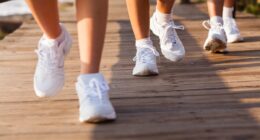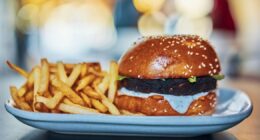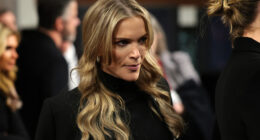My work used to land in the form of harsh clacking on a titanium-reinforced MacBook, but these days I prefer to write in a pale blue suedette notebook that was given to me by a relative a few Christmases ago. It is an object that until recently I had kept at the back of a drawer, fearing it would seem too sappy a thing for a serious writer to own.
It forms part of a new tendency in my life towards softness – the quality of being gentle to the touch, sensual and pliable, but also receptive, yielding and adaptive. As an antidote to our digitally enhanced lives, which can appear to be cold and hyper-real, softness seems to be on the rise. There is the “girlhood aesthetic”, which is the nostalgic use of bows, frills and smock dresses. In literature, Arrangements in Blue by Amy Key chronicles the author’s journey to creating a soft and cosseting home environment, while the hugely popular Milk Fed by Melissa Broder is a love letter to fleshiness and abundance.
I was perhaps more aware of this trend due to misfortunes in my own life that had prompted an interrogation into the harder parts of my personality. For years, I had fashioned a persona that was steely and unbothered – and it had served me well. I was armour-plated and harsh judgments from other people would fly off me. But when that brittle energy ran out and the insecurities it concealed became clear, something had to change. I woke up in my early 30s with a partner who was abusive, leading to me being unable to live in the flat that I had bought on my own due to safety concerns.
A women’s service stepped in to help and I arrived to see a therapist feeling furious and full of very fixed ideas about what needed to be done. I placed both elbows on the armrest of the chair opposite her and squared my shoulders. When I failed to understand her methods and mistook them as a sign of stupidity, I argued back. Like all good therapists, she did not react or punish me, but led me slowly to a place of healing by granting me the permission to be myself. This was not a self I recognised at first, concealed as it was behind so many harsh judgments.
For a few weeks, I was set the task of giving myself whatever I wanted, which is to say that I ate everything that was delicious. I avoided the gym. I went on gentle walks instead of doing gruelling exercises, and – if I felt like it – had a pint of Guinness at the end. The process continued and over the subsequent weeks and months, I noticed that colour had started to return to my face, as had the padding around my belly and thighs that I had banished with the onset of adolescence.
At the same time, I found myself more drawn to that which was luscious and warm: soft bedlinen and cushions, sheepskin soles, lamps that only permit warm, dim light. I am not someone who has ever needed to assert my femininity, but in anticipating the judgments of other people, I realised the idea of these warm, comforting things being too girlie or feminine (terms that have always been to some extent pejorative), was probably a reflection of society’s emphasis on productivity.
Whether my newfound appreciation for softness was borne of happiness, or vice-versa, is irrelevant: the two, I realised, were connected. Part of this was also discovering the work of Yasmin El Yassini, the gothic model and actor who has been steadily supplanting beauty standards in the fashion industry. With long black, unstyled hair, pale skin, a round belly and large, doleful eyes, everything about El Yassini’s approach to beauty posed a challenge to the hyper corporate and controlled industries of taste and consumer desire.
“Tenebrism” is the word used to describe the dimly lit aspect of paintings by artists such as Caravaggio and Rembrandt, where bodies, instead of being stark and definitive in their outline, appear more like flesh materialising from the shadows. El Yassini’s pictures capture something of this, and their contrast with the digitally enhanced appearance of almost everything online was instantly captivating to me.
I met El Yassini in late 2023, just after she had appeared in a viral video discussing the thrifted and often threadbare clothes she wears draped, sewn together and assembled with a lot of creative licence. I had started to see her as something of a soft icon. She attributes her personal style to empathy. Rather than adopting the combative approach to confidence made popular by so many lifestyle coaches, of “being yourself” and ignoring the judgment of other people, El Yassini views it as the flipside to kindness.
“I have never had much confidence,” she said. “I had eating disorders as a child and starved myself after a model scout told me I needed to lose weight. But by practising regular meditation I felt myself become more compassionate. I softened. If I wouldn’t treat a friend cruelly, then why would I do that to myself?”
El Yassini is playful with the contours of her body. “I don’t like thinking of myself as a size,” she says, “so if I find something I like in a secondhand shop, I take it home and adjust it to make it fit.” Feeling rather than perception is what’s really at the heart of El Yassini’s approach and she is one of many women promoting softer expectations of the body in the popular imagination. Another is Michaela Stark, the designer who is challenging the hard eggshell appearance of the fashion model ideal, through elaborate corsetry aimed at emphasising, rather than concealing, its softer parts. As the flesh bulges from Michaela Stark’s corsets, there is also a message of freedom: a breaking loose.
The perfectly imperfect state of being alive is miraculously back in vogue, prompting the question: what if clothes worked for us, and were selected for the comfort and compatibility with our bodies, rather than conceived as something that we need to master and fit ourselves into? Psychologist Annouchka Grose’s recent book Fashion: A Manifesto, makes the case for a more embodied approach to clothing with softness at its core.
“If there’s any doubt about the importance of touch – in particular, the warmth and softness of fabric,” writes Grose, “we might remember Harry Harlow’s heartbreakingly cruel experiments with macaque monkeys. As part of his research into maternal attachment, he placed baby monkeys in cages with two possible “mothers” – one made of wire, the other from cloth… What he discovered was that the monkeys overwhelmingly preferred the cloth mother, whether she had milk or not. The babies would take milk from the wire mother, but return to the cloth one, demonstrating that food isn’t the only factor in early bonding.”
Grose goes on to cite the political scientist Iris Marion Young who, in her 1994 essay, Women Recovering Our Clothes, argued “for the tactility of clothing as a feminist riposte to its male-gaze-pleasing dimensions. Rather than thinking about how our clothes make us look, we might be better off thinking about how they make us feel.”
Shortly after meeting El Yassini, I visited an exhibition of the Flemish master Peter Paul Rubens, famous for his obsession with fat women, supposedly, but walking around the show it seemed just as clear to me that Rubens was interested in movement, his paintings concerned with the blur of unselfconscious bodies moving through space, and the fourth dimension of time increasing their size. These are free-flowing bodies that melted into one another as they moved through air, rippling and folding. Likewise, at a recent retrospective of the artist John Singer Sargent, the viewer was surrounded by portraits of women horizontal and drowned in soft fabric, their lazy, leisurely selves made huge by the opulence of their clothing, double chins in full view.
I’m not saying therapy and exercise and eating healthily are redundant but, for me at least, the penny seems to have dropped that we can soothe ourselves. Life goes on, work is unavoidable, but finding ways to regularly swaddle ourselves is no longer negotiable. Perhaps the revolution is already upon us and involves much more sleep, silk and whipped cream than anyone imagined.
Bad Taste: Or the Politics of Ugliness by Nathalie Olah is published by Dialogue at £18.99. Buy it for £16.71 from guardianbookshop.com





